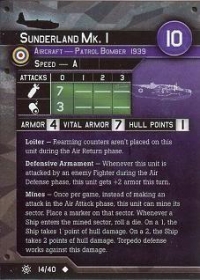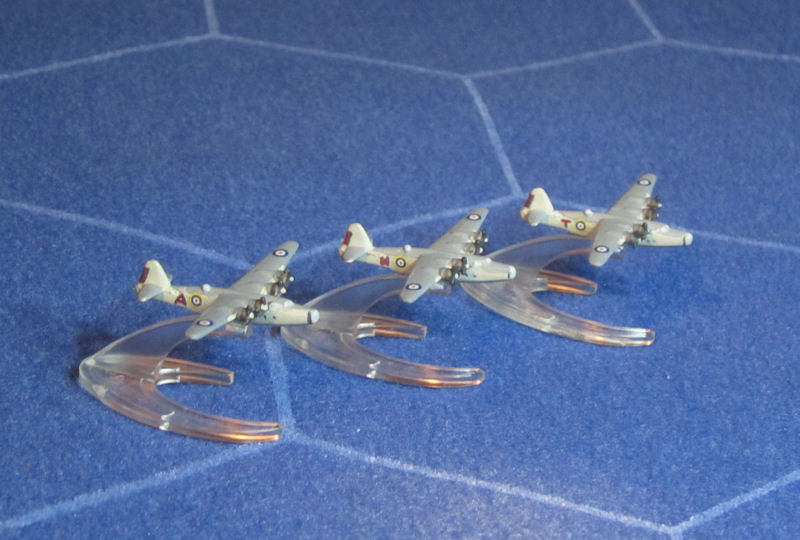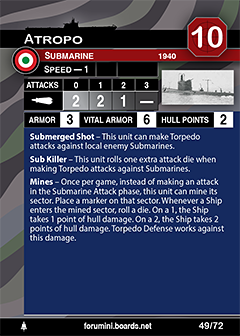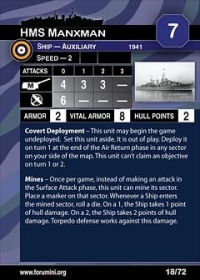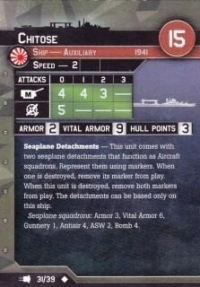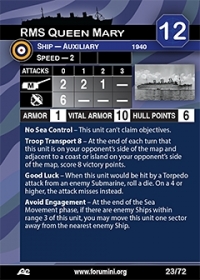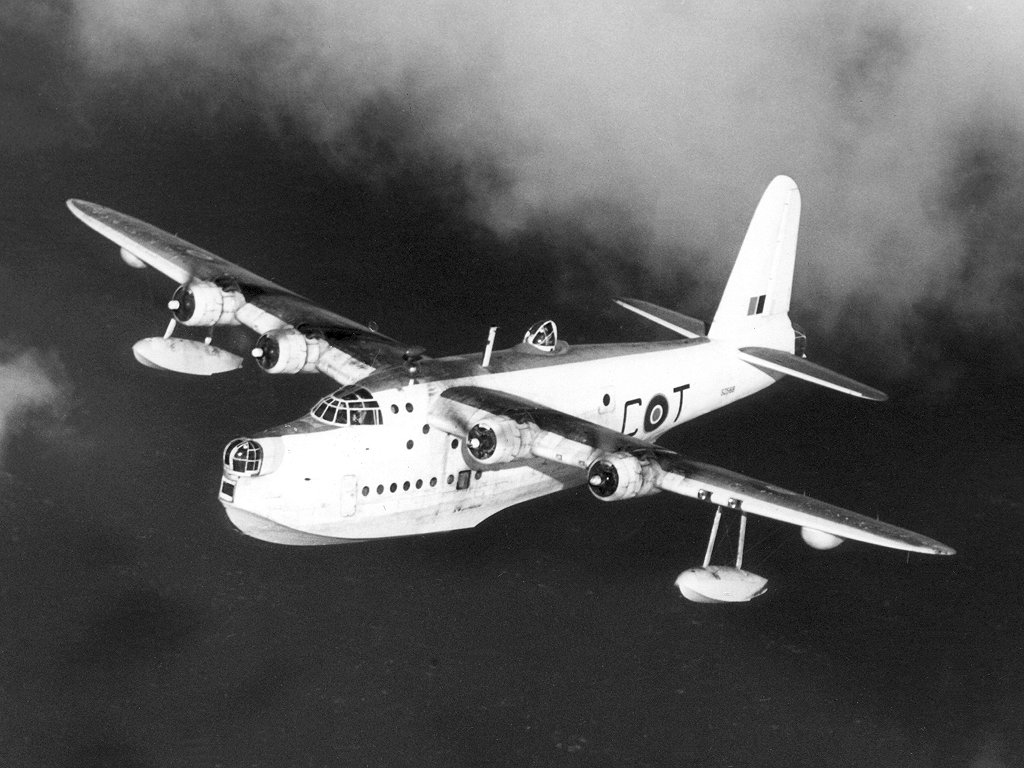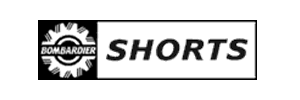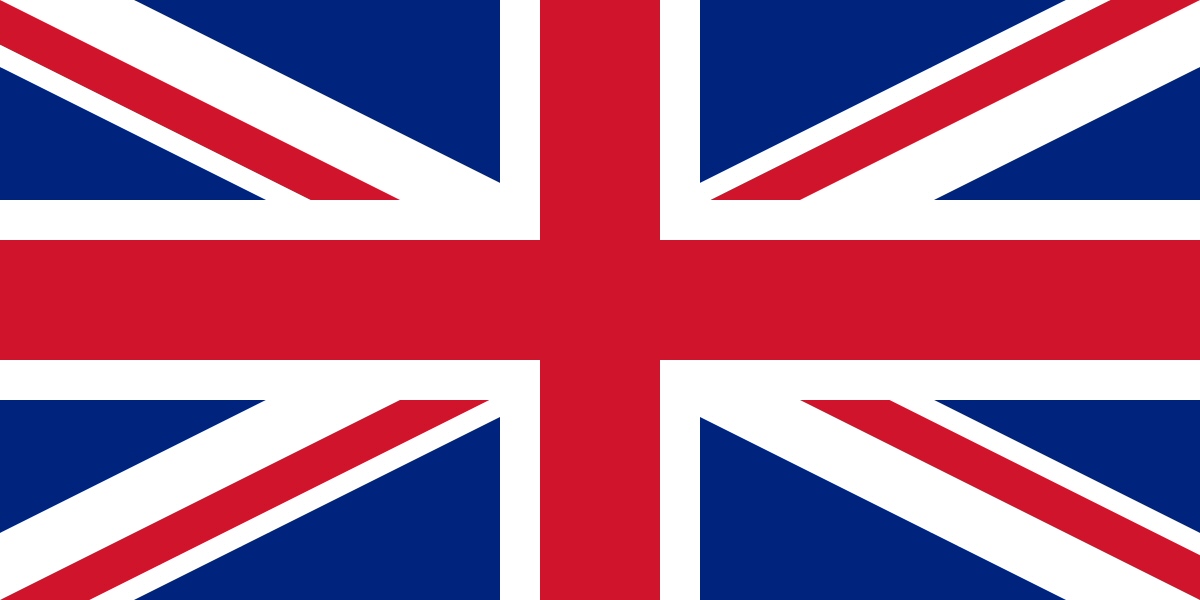Sunderland Mk. I
| General Type | Aircraft |
| Unit Type | Patrol Bomber |
| Cost | 10 |
| Set | Condition Zebra |
| Manufacturer | Hasbro |
| Available | 1939 |
| Set ID | 14 |
| Game Class Limits | Short Brothers |
| Country | United Kingdom (Details) |
| Prototype | Aircraft, Flying Boat, Short Sunderland (Details) |
| Armor | 4 |
| Vital | 7 |
| Hull Points | 1 |
| Speed | 139 |
| Primary | 0/0/0/0 |
| ASW | 3/-/-/- |
| Bomb | 7 |
| Special Ability | Loiter |
| Special Ability | Defensive Armament |
| Special Ability | Land Based |
| Game Rarity | U |
Click to see the details
market
Click to see the details
history
Aircraft History:
The Short S.25 Sunderland was a British flying boat patrol bomber, developed and constructed by Short Brothers for the Royal Air Force (RAF). The aircraft took its service name from the town (latterly, city) and port of Sunderland in North East England.
Developed in parallel with the civilian S.23 Empire flying boat, the flagship of Imperial Airways, the Sunderland was developed specifically to conform to the requirements of British Air Ministry Specification R.2/33 for a long-range patrol/reconnaissance flying boat to serve with the Royal Air Force (RAF). As designed, it served as a successor to the earlier Short Sarafand flying boat. Sharing several similarities with the S.23, it featured a more advanced aerodynamic hull and was outfitted with various offensive and defensive armaments, including machine gun turrets, bombs, aerial mines, and depth charges. The Sunderland was powered by four Bristol Pegasus XVIII radial engines and was outfitted with various detection equipment to aid combat operations, including the Leigh searchlight, the ASV Mark II and ASV Mark III radar units, and an astrodome.
Developed in parallel with the civilian S.23 Empire flying boat, the flagship of Imperial Airways, the Sunderland was developed specifically to conform to the requirements of British Air Ministry Specification R.2/33 for a long-range patrol/reconnaissance flying boat to serve with the Royal Air Force (RAF). As designed, it served as a successor to the earlier Short Sarafand flying boat. Sharing several similarities with the S.23, it featured a more advanced aerodynamic hull and was outfitted with various offensive and defensive armaments, including machine gun turrets, bombs, aerial mines, and depth charges. The Sunderland was powered by four Bristol Pegasus XVIII radial engines and was outfitted with various detection equipment to aid combat operations, including the Leigh searchlight, the ASV Mark II and ASV Mark III radar units, and an astrodome.
Manufacturer:
Short Brothers plc, usually referred to as Shorts or Short, is an aerospace company based in Belfast, Northern Ireland. Shorts was founded in 1908 in London, and was the first company in the world to make production airplanes. It was particularly notable for its flying boat designs manufactured into the 1950s.
In 1943 Shorts was nationalised and later denationalised, and in 1948 moved from its main base at Rochester, Kent to Belfast. In the 1960s, Shorts mainly produced turboprop airliners, major components for aerospace primary manufacturers, and missiles for the British Armed Forces.
In 1989 Shorts was bought by Bombardier, and is today the largest manufacturing concern in Northern Ireland. Prior to that merger, the authorised capital share by the owner was: HM Government, 69.5% (majority share); Rolls-Royce Ltd, 15.25%; Harland & Wolff Ltd, 15.25%.
The company's products include aircraft components, engine nacelles and aircraft flight control systems for its parent company Bombardier Aerospace, and for Boeing, Rolls-Royce Deutschland, General Electric and Pratt & Whitney.
In 1943 Shorts was nationalised and later denationalised, and in 1948 moved from its main base at Rochester, Kent to Belfast. In the 1960s, Shorts mainly produced turboprop airliners, major components for aerospace primary manufacturers, and missiles for the British Armed Forces.
In 1989 Shorts was bought by Bombardier, and is today the largest manufacturing concern in Northern Ireland. Prior to that merger, the authorised capital share by the owner was: HM Government, 69.5% (majority share); Rolls-Royce Ltd, 15.25%; Harland & Wolff Ltd, 15.25%.
The company's products include aircraft components, engine nacelles and aircraft flight control systems for its parent company Bombardier Aerospace, and for Boeing, Rolls-Royce Deutschland, General Electric and Pratt & Whitney.
Country:
The United Kingdom, made up of England, Scotland, Wales and Northern Ireland, is an island nation in northwestern Europe. England – birthplace of Shakespeare and The Beatles – is home to the capital, London, a globally influential centre of finance and culture. England is also site of Neolithic Stonehenge, Bath’s Roman spa and centuries-old universities at Oxford and Cambridge.
Item created by: Lethe
on 2015-05-31 17:46:30
Last edited by: gdm on 2019-09-17 18:51:18
If you see errors or missing data in this entry, please feel free to log in and edit it. Anyone with a Gmail account can log in instantly.
Last edited by: gdm on 2019-09-17 18:51:18
If you see errors or missing data in this entry, please feel free to log in and edit it. Anyone with a Gmail account can log in instantly.


